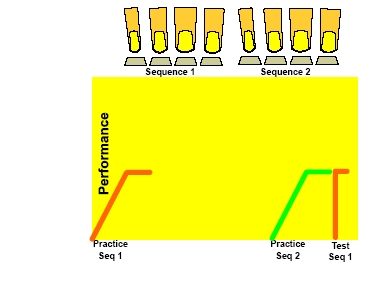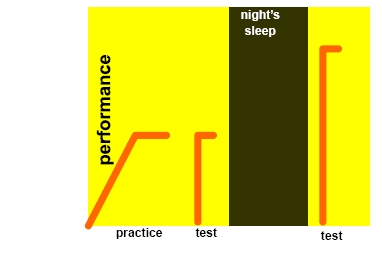Down memory lane
New memories are labile. If you learn a sequence of finger taps, and soon after you learn a second sequence, the skills (speed and accuracy) of the first sequence is disrupted by interference.
Over a period of several hours, the memory undergoes consolidation, making it resistant against interference. Now learning a second sequence will not disrupt the first.

Surprisingly after a memory has been consolidated, brief rehearsel returns the memory into a labile state. Normally rehearsel would refine the learnt sequence. However this can also have negative consequences. After a brief rehearsel of sequence 1, the memory becomes labile. If you you then practice sequence 2, the skills of sequence 1 will be reduced.

Memories improve during sleep. The performance of a learnt motor skill is enhanced during the night.

I have done quite a few experiments lately to find out what's the best schedule. Those experiments revealed a lot of delusions in my thinking about memory. I always thought it would be best to wait untill a memory has sunken into the mud before you rehearse it. But that's not how it works best. The brains learn best when it is in a labile state. So the first session I train, I do the problemset 4-5 times in a row, until I can do them without thinking. The second training session must follow before the memory is forgotten! Typical whithin 24 hours. Here is where spaced repetition comes in. In the second session I repeat the set 1-2 times, until I can do it without thinking. The third session must be done too before the memory has faded. And so on.
Since a few days I work according to this scheme. I'll keep you informed about the results.
The discussion about socks and amount of patterns hasn't lead to a definite conclusion yet. It's time to think it over and work thinks out. You can't sow and harvest on the same day as an old chinese saying goes.

Over a period of several hours, the memory undergoes consolidation, making it resistant against interference. Now learning a second sequence will not disrupt the first.

Surprisingly after a memory has been consolidated, brief rehearsel returns the memory into a labile state. Normally rehearsel would refine the learnt sequence. However this can also have negative consequences. After a brief rehearsel of sequence 1, the memory becomes labile. If you you then practice sequence 2, the skills of sequence 1 will be reduced.

Memories improve during sleep. The performance of a learnt motor skill is enhanced during the night.

I have done quite a few experiments lately to find out what's the best schedule. Those experiments revealed a lot of delusions in my thinking about memory. I always thought it would be best to wait untill a memory has sunken into the mud before you rehearse it. But that's not how it works best. The brains learn best when it is in a labile state. So the first session I train, I do the problemset 4-5 times in a row, until I can do them without thinking. The second training session must follow before the memory is forgotten! Typical whithin 24 hours. Here is where spaced repetition comes in. In the second session I repeat the set 1-2 times, until I can do it without thinking. The third session must be done too before the memory has faded. And so on.
Since a few days I work according to this scheme. I'll keep you informed about the results.
The discussion about socks and amount of patterns hasn't lead to a definite conclusion yet. It's time to think it over and work thinks out. You can't sow and harvest on the same day as an old chinese saying goes.
Interesting post, though I am not sure I have fully understood. You always lay a heavy emphasis on memory and do a lot of work memory-wise. For my part, I am a bit sceptical about memory. Just take a distant loose piece and a king that can be forked by a queen check, making use of a diagonal that is hidden behind a jungle of crowded pieces. Now, my memory just tells me that I must look for queen forks if queens are on the board and kings are exposed to checks and there are loose pieces around. But it is impossible to store all such situations in memory. Surely, memory must be a part of pattern recognizing. The question is about what are the important elements stored there. Are they complex structures and patterns or rather a lot of very simple elements together with very simple procedures to combine, sort and filter them? I do not know the answer, but I think it is very important for what sort of training will work best.
ReplyDeleteI don't know how it works. Science doesn't know. So we have to find out ourselves by experimenting and logical reasoning.
ReplyDeleteIf I look at the sky, it is easy to recognize a rabbit in a cloud. Or a map of Holland. We can recognize patterns in an amazing variety of ways. With enormous flexibility. So why is it so difficult to recognize patterns on a crowded board? Is it the interference that tricks us? I don't know.
If I look at a cloud with the shape of Switzerland, or Oklahoma, I would have trouble to recognize it. Since I'm not very familiar with it. If I see Switzerland, it's always on a map of Europe. And Europe has a few forms that are far more remarkable than Switzerland. To name a few: Spain, Italy, Scandinavian. Those I would recognize even in very distorted cloud. Since fantasy fills in the details.
To recognize Switzerland I first have to be more familiar with its shape. Now I have only a vague ellips with random ravels.
And here is the problem. The brains are extremely efficient. So it doesn't like to store objects in detail. It stores only a few outlines and the rest is reconstructed on the fly. But a pattern you haven't stored, you cannot recognize. Once you have it stored, you can recognize it even in very distorted situations.
So you have to persuade your mind to be very uneconomical, and to store patterns in detail. The mind resists, however.
How few details you actually store you can read in an old post http://temposchlucker.blogspot.com/2005/02/chess-visualisation-training.html
I think a sort of filter must be involved. For me, it filters switzerland-shaped objects, for you it filters netherland-shaped ones. And here comes another point. Patterns can be coherent objects such as pawn forks, king forks or close queen forks. They can also be non-coherent, such as distant queen forks. Knight forks are a bit intermediate, because they can present either as coherent or as non-coherent, for example spaced knight forks on a crowded board. I would say that coherent patterns can jump right into the eye, whereas non-coherent patterns must be searched actively, guided by simple hints.
ReplyDeleteThe reason why I focus on memory, is that that is where grandmaster and amateurs differ, according to brainscans. Your active search, guided by simple hints would generate a firing pattern on brainscans just in the place where amateurs used to focus their brainactivity.
ReplyDeleteMaybe I am just too lazy to build up a huge memory (achoo!). Therefore, instead, I try to optimize quick search, sorting and handling a set of very simple elements. Let's see how far this approach will bring me.
ReplyDeleteTempo,
ReplyDeleteJust remember that Oklahoma looks like a deep frying panover an open flame. . .the temperatures this summer were hot enough to prove it, too!